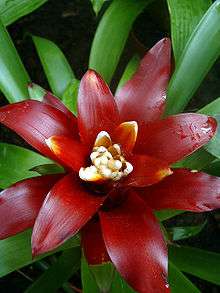Tillandsioideae
| Tillandsioideae | |
|---|---|
| | |
| Tillandsia fasciculata | |
| Scientific classification | |
| Kingdom: | Plantae |
| (unranked): | Angiosperms |
| (unranked): | Monocots |
| (unranked): | Commelinids |
| Order: | Poales |
| Family: | Bromeliaceae |
| Subfamily: | Tillandsioideae |
| Genera | |
|
See text. | |
Tillandsioideae is a subfamily of plants in the bromeliad family Bromeliaceae. This group contains the fewest genera (9) but the greatest number of species (1,277). Most are epiphytic or lithophytic, growing in trees or on rocks where they absorb water and nutrients from the air. Spanish moss of the Tillandsia genus is a well-known variety. Bromeliads in the genera Guzmania and Vriesia are the more commonly cultivated members of this subfamily.
Description
Nearly all bromeliads have specialized cell groups called trichomes which form scales on the foliage. The trichomes occurring on Tillandsioideae may cover the plants so completely that they appear grey or white, like Spanish moss. In addition to absorbing nutrients, the trichomes may serve to insulate the plant from freezing weather.
Plants in this group have smooth or entire leaf margins, unusual color and markings, with many producing fragrant flowers. All their leaves are spineless (unarmed) and their fruit is a dry capsule containing winged seeds which are usually dispersed by breezes. Feathery seed plumes help them to adhere to a suitable epiphytic surface for germination. This subfamily is probably the most derived with special adaptations for survival in very dry conditions, with many described as xerophytes.
Genera
The 9 genera are:
- Alcantarea (23 species)
- Catopsis Griseb. (18 species)
- Glomeropitcairnia (2 species)
- Guzmania Ruiz & Pav. (207 species)
- Mezobromelia (9 Species)
- Racinaea (61 species)
- Tillandsia L. (609 species)
- Vriesea Lindl. (261 species)
- Werauhia J.R.Grant (87 species)
- Tillandsia sp.
 Tillandsia excelsa in bloom
Tillandsia excelsa in bloom
References
- BSI - Bromeliad Info - Taxonomy
- Black, Robert J.; Bijan Dehgan. "Bromeliads". Electronic Data Information System. University of Florida IFAS Extension.
- "Superorder Commelinanae". Texas A&M University Bioinformatics Working Group. 1999-04-03.
- Luther, H. E. (2008) An Alphabetical List of Bromeliad Binomials, Eleventh Edition The Marie Selby Botanical Gardens, Sarasota, Florida, USA. Published by The Bromeliad Society International.
External links
| Wikispecies has information related to: Tillandsioideae |
| Wikimedia Commons has media related to Tillandsioideae. |